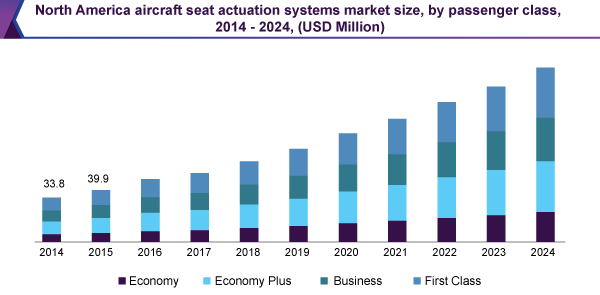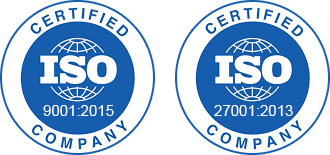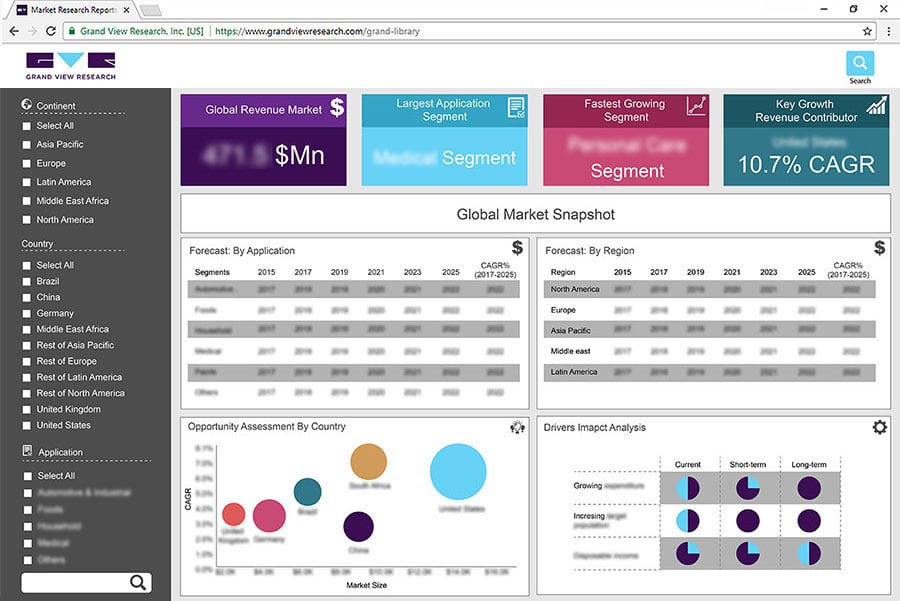- Home
- »
- Automotive & Transportation
- »
-
Aircraft Seat Actuation Systems Market, Industry Report, 2018-2024GVR Report cover
![Aircraft Seat Actuation Systems Market Size, Share & Trends Report]()
Aircraft Seat Actuation Systems Market Size, Share & Trends Analysis By Passenger Class (Economy, Economy Plus, Business, First Class) By Mechanism (Linear, Rotary), By Actuator Type, By Region, And Segment Forecasts, 2018 - 2024
- Report ID: GVR-1-68038-049-1
- Number of Report Pages: 63
- Format: PDF, Horizon Databook
- Historical Range: 2014 - 2015
- Forecast Period: 2016 - 2024
- Industry: Technology
Industry Insights
The global aircraft seat actuation systems market size was valued at USD 228.2 million in 2016, expanding at a CAGR of 14.1% over the forecast period. The market is anticipated to foresee significant growth, primarily due to increasing demand for lighter aircraft that facilitates high fuel efficiency and lower operational costs.
Aircraft manufacturers are increasingly emphasizing on reducing basic Operating Empty Weight (OEW) of the aerial vehicle by using lightweight equipment and furniture. Minimized payload helps in gaining higher fuel efficiency, thereby propelling demand for lighter seating systems.

Increasing level of disposable consumer income across the globe is significantly impacting demand for premium air travel. Moreover, Asia Pacific and Latin America regions are expected to offer immense opportunities for market growth. This can be majorly attributed to presence of emerging nations such as India, China, South Korea, and Brazil.
A booming aircraft market is anticipated to directly propel demand for seat actuating systems, as they are an integral part of airplanes. However, low-frill airplanes are expected to hinder industry growth as they prefer economical and cheaper means of air travel. Thus, ignoring the need for sophisticated in-flight comfort facilities and features, these airlines threaten market growth.
Commercial airlines are heavily priced and bring along high maintenance costs, thereby, discouraging industry players from placing large airline orders. Macroeconomic conditions and lethargic economic growth are affecting the airline industry, subsequently affecting demand for airline seat actuation systems.
Mechanism Insights
On the basis of mechanism, the industry can be classified into two types, namely, linear and rotary. The linear mechanism segment dominated the market and was valued at USD 40.5 million in 2015. It is projected to retain its dominance over the coming years, primarily due to advantages offered by them, such as enhanced reclined axes, and comfort features such as footrest and leg rest.
The rotary mechanism segment accounted for over 28.0% of the total market in 2015. The segment is anticipated to expand its market share, owing to its 360-degree rotation capabilities, along with smooth operation and reduced noise features.
Actuator Type Insights
The industry can be classified on the basis of actuator type into electro-mechanical systems and others. The electro-mechanical segment dominated the market and acquired more than 71.0% of the total market in 2015. This growth can be attributed to higher efficiency offered by electromechanical actuators.
The segment is anticipated to retain its dominance in the aircraft seat actuation systems market throughout the forecast period, owing to increasing benefits provided by them, such as reduced energy consumption, minimal maintenance costs, and low operating costs.
Passenger Class Insights
On the basis of passenger class, the market can be divided into four types namely, economy, economy plus, business, and first-class. The economy plus segment dominated the market and accounted for more than 27.0% of the total market in 2015.

The segment is also projected to register the fastest growth over the forecast period, owing to high level of comfort offered by them during long hauls. Moreover, enhanced in-flight entertainment features are gaining popularity, which is leading to an upsurge in demand.
Regional Insights
The European market accounted for over 34.0% of the global market in 2015. This can be attributed to presence of key aircraft and seat actuator system manufacturers in the region. However, North America is anticipated to offer immense opportunities for industry expansion owing to increasing trade-related activities that are expected to generate high demand for business jets.
Asia Pacific and Latin America regions are projected to gain momentum during the forecast period. This can be attributed to growing income levels among all economic groups and rising demand for air travel in countries such as China, India, South Korea, and Brazil.
Aircraft Seat Actuation Systems Market Share Insights
Key industry players offering seat actuation systems for aircraft include ITT Corporation (U.S.); Nook Industries Inc. (U.S.); Moog, Inc. (U.S.); Rollon S.P.A. (Italy); and Shandong Jinglu Industrial Control System Co. Ltd. (China).
Presence of numerous market players has intensified industry rivalry. In spite of high competition levels, few players are able to capture considerable market share due to slight product differentiation. Furthermore, highly diverse mechanisms and actuator types have created substantial opportunities for industry vendors.
Segments Covered in the Report
This report forecasts revenue growth at the global, regional, and country levels, and provides an analysis of the latest industry trends in each of the sub-segments from 2014 to 2024. For the purpose of this study, Grand View Research has segmented the global aircraft seat actuation systems market report based on passenger class, mechanism, actuator type, and region:
-
Passenger Class Outlook (Revenue, USD Million, 2014 - 2024)
-
Economy
-
Economy plus
-
Business
-
First-class
-
-
Mechanism Outlook (Revenue, USD Million, 2014 - 2024)
-
Linear
-
Rotary
-
-
Actuator Type Outlook (Revenue, USD Million, 2014 - 2024)
-
Electro-mechanical
-
Others
-
-
Regional Outlook (Revenue, USD Million, 2014 - 2024)
-
North America
-
Europe
-
Asia Pacific
-
RoW
-
Share this report with your colleague or friend.
![gvr icn]()
NEED A CUSTOM REPORT?
We can customize every report - free of charge - including purchasing stand-alone sections or country-level reports, as well as offer affordable discounts for start-ups & universities. Contact us now
![Certified Icon]()
We are GDPR and CCPA compliant! Your transaction & personal information is safe and secure. For more details, please read our privacy policy.
We are committed towards customer satisfaction, and quality service.
"The quality of research they have done for us has been excellent."





